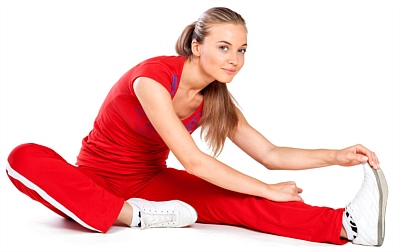Ballet dancers aim to be strong, slim and flexible. That is why they need to do a lot of ballet stretching exercises to keep their bodies supple.
Here are some ideas and ballet stretch exercises to look at doing regularly.
Although certain muscle groups predominate, a ballet dancer uses all of their muscle groups. As the dancer spends much time developing their technique and form, they must also dedicate a portion of their training time to a stretching program.
Ballet dancers, just like gymnasts need to be able to achieve an extensive range of motion. They especially need to get flexibility in their backs, hips, and ankles, which allows for certain movements and ballet lines to be created, to make their dancing look graceful and easy.
What Muscles Does A Ballet Dancer Need to Focus Her Ballet Stretching Exercises On?
These are the muscle groups that are used predominantly by ballet dancers:
- Hip muscles and in particular the hip flexors. Dancers with tight hip flexors and weak abs will cause increased disk compression in the spinal column.
- The muscles of the lower back are held erect by the abdominals, obliques, erector muscles of the spine, and the quadratus lumborum.
- Core muscles, which include the obliques, rectus abdominous and the spinal erectors.
- The hamstrings are also very important, and a dancer uses these muscles in almost every movement. A lack of flexibility here will cause more compression of the vertebrae of the lower back.
So Why Do Ballet Stretch Exercises

Ballet dancers need to stretch after each class and incorporate it into their training. Any athlete needs to stretch out his or her muscles after working them, or they will get very stiff over time.
Stretching will prevent many injuries as well as muscle strain.
The areas that need the most attention for a dancer will be the hip flexors, hamstrings, and calves. They also need to work on their turnout from the hip socket.
What are the Best Ballet Stretch Exercises?
Stretching is one of the most under-utilized techniques for improving athletic performance, preventing sports injuries, and properly rehabilitating sprain and strain injuries. Don’t make the mistake of thinking that something as simple as stretching won’t be effective.
Here are some of the best ballet stretching exercises, even though they don’t feel very balletic.
Even though they may seem simple, don’t underestimate the benefits that you will get as both a dancer and athlete.
Achilles Stretch:
Stand on a step. Place the ball of one foot on the edge of the step. Bend your knee slightly and let your heel drop as far down as it will go.
To strengthen, you can do some raises and let both heels drop below the step as you go down.
Do this exercise in both a turned-out position, a parallel position, and then a turned-in position.
Quad Stretch:
Stand upright and take a small step forward. Reach up with both hands as you push your hips forward. Lean back and then lean away from your back leg.
You can deepen this stretch by going down further into a lunge. Stretch the back leg and make sure the front knee is not going over your front toe. Feel the stretch in your hip flexors.
Then place your back knee on the floor and rest on top of your kneecap. Turn the opposite way, bend your leg, and grab onto your foot. Gently press the hips further down to the floor. You should feel a tremendous stretch down the front of your thigh and through your hip flexor if it is tight.
Hamstring Stretch:
Place a chair in front of you. Reach down towards it with your upper body and grab onto the back of the chair with your hands. Your body should look like a table with your legs and back at 90 degrees. Gently arch your back and feel the stretch deepen up the backs of your legs.
You can try this exercise with your feet parallel together, parallel apart, or in ballet first and then in ballet second.
For more great ballet stretching exercises, you can click here.
Are You Looking For A Great Stretching Program?
You can click here to get one of the best programs available online today.

While the recommendations on this page are a good starting point, you’ll get a lot more benefit when you include a wider variety of stretches.
To do away with stiff, tight muscles and joints, and improve your full body mobility and freedom of movement, grab a copy of the Ultimate Guide to Stretching & Flexibility(Handbook, DVD & CD-ROM).
In total, they include 135 clear photographs and 44 video demonstrations of unique stretching exercises for every major muscle group in your body. Plus, over 80 printable stretching routines for 22 sports and 19 different muscle groups.
The DVD also includes 3 customized stretching routines (8 minutes each) for the Upper Body; the Lower Body; and the Neck, Back & Core, plus a bonus CD-ROM that allows you to print out over 80 stretching routines that you can take with you wherever you go.
The Handbook and DVD will show you, step-by-step, how to perform each stretch correctly. Plus, you’ll also learn the 7 critical rules for safe stretching; the benefits of flexibility; and how to stretch properly.

